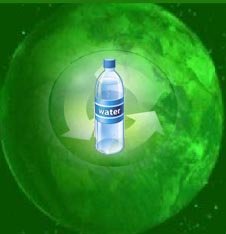Home | Water wisdom | Plastic Vs. Green |
Energy | Green Entertainment | Wear Green

Home | Water wisdom | Plastic Vs. Green |
Energy | Green Entertainment | Wear Green

Basic Throw-Away Bottle
Nalgene or Similar Water Bottle
Opaque Nalgene or Similar Water Bottle
What it�s made of: HDPE High-density polyethylene (softer and opaque and made from petroleum)Key Things to Know: No known problems.Use or Don�t Use: The jury�s still out. No known problems to date.
Klean Kanteen or Stainless Steel
What it�s made of: Stainless Steel (both inside and out). See note on Sigg water bottles below.Key Things to Know: Klean Kanteens don�t leach (or contain) BPA.Use or Don�t Use: Use.
Other Water Bottles:
Sigg:There is a HUGE debate over Sigg stainless steel water bottles. They are lined, and the lining most likely contains a trace amount of BPA. Sigg won�t come out and say the bottles contain no BPA, which is what makes them suspicious. (Read the debate here in comments or here.)
new CamelBak (Tritan) or new Nalgene Choice (Tritan): Because of the concerns with BPA and phthalates, water bottle companies are now starting to use a different compound called Tritan. As I mentioned in my review of a BPA free Better Bottle by CamelBak, thus far tests have revealed no problems with Tritan. Tritan is a copolyester and while I�m not a chemical expert, this makes me a little wary. (Though it�s definitely better than BPA-leaching bottles.)
Water bottles with soft �nipples�/valves:The soft plastic �nipple� or valve (see an example of a water bottle with what I�m talking about at REI) that you drink from likely contains phthalates. Phthalates are hormone disruptors that have been linked to reproductive problems and birth defects.
Glass: Glass is safe. If you don�t mind the weight, glass is an extremely safe bet. Thanks to Aaron�s suggestion, you can find glass bottles at Aquasana.
Bottled Water
If you have your doubts about the harm of everyday bottled water, wait until you see our coverage of strange waters: water that makes you skinny, water for dogs, water that is sung to and infused with good intentions, and water with gold in it. Some bottled waters like Biota and Jivita are now using containers made from cornstarch, also known as polylactic acid (PLA). While these are non-petroleum products and are, in theory biodegradable, they are not recyclable and most likely will never break down in your backyard compost pile. Some companies like Ethos and HtoO are doing constructive things with their profits, but they still are responsible for the many ecological impacts of bottled water.
What it�s made of: PET (Polyethylene terephthalate)
Key Things to Know: With reuse, PET can degrade and because the plastic is thin and wrinkled it can build up germs. It can also leach DEHP, a probable carcinogen.
Use or Don�t Use: Don�t reuse.
Other Resources:
What it�s made of: Polycarbonate (a thermoplastic polymer)
Key Things to Know: Polycarbonates leach a hormone disrupting chemical, bisphenol A (BPA), even at room temperature. See the resources section below for more about BPA.
Use or Don�t Use: Don�t use. (If you want another reason to not use Nalgene check out this picture.)
Other Resources:
Other Resources:
Other Resources:
Other Resources: